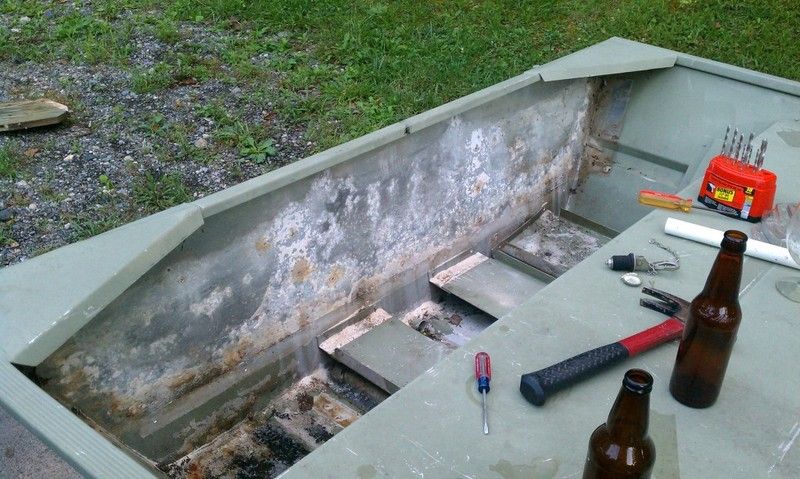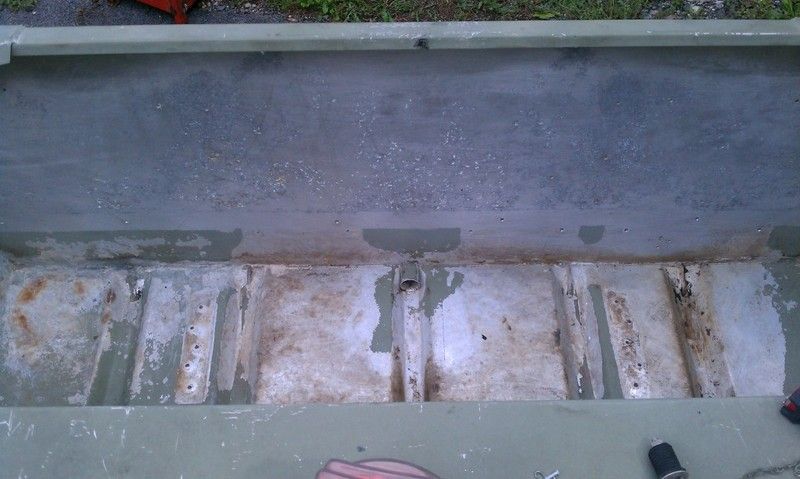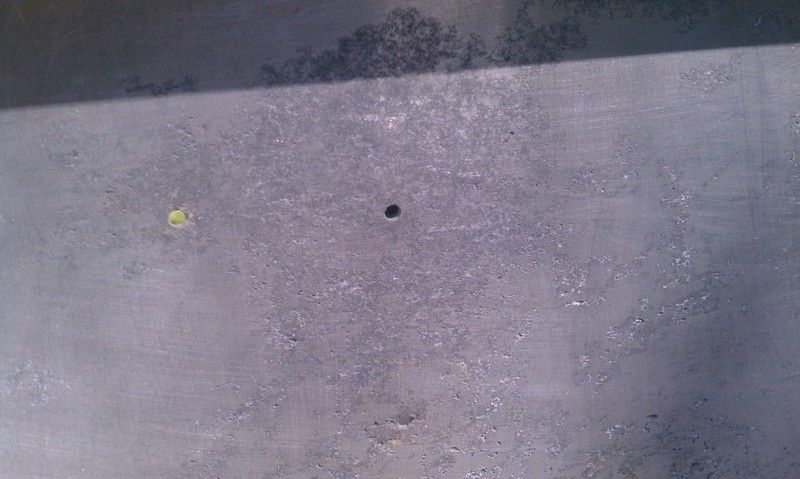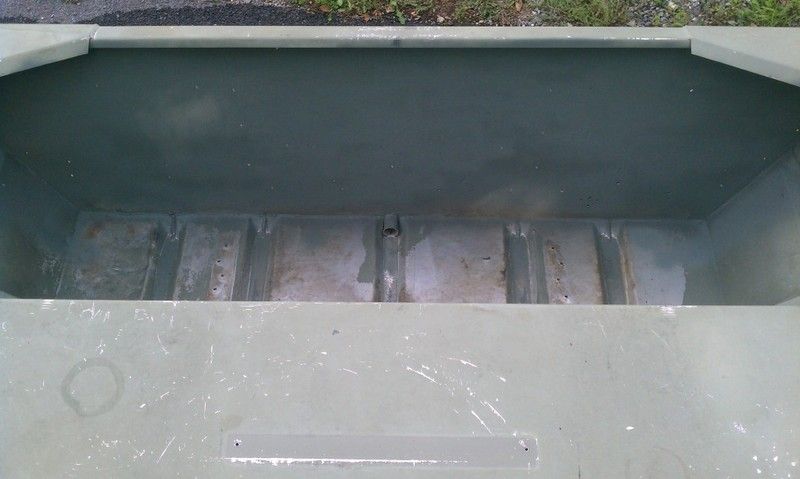Ive used the search but haven't found what i'm looking for. Currently replacing my transom and under the wood the aluminum has a slight corrosion white powder build up. What are some ways i can treat this with chemicals to clean the corrosion and prevent any holes in my transom?
You are using an out of date browser. It may not display this or other websites correctly.
You should upgrade or use an alternative browser.
You should upgrade or use an alternative browser.
Corrosion
- Thread starter ROOSTER87
- Start date

Help Support TinBoats.net:
This site may earn a commission from merchant affiliate
links, including eBay, Amazon, and others.
Skiffing
Well-known member
Post some pictures. How much corrosion? Check for holes.. Might be better off re-skinning it.
Diluted muriatic acid.... Maybe 5% - 10% solution.
Rinse.
Buff w/ Scotch Brite
Dremel if needed to get into pits.
Repeat.
Diluted muriatic acid.... Maybe 5% - 10% solution.
Rinse.
Buff w/ Scotch Brite
Dremel if needed to get into pits.
Repeat.
lckstckn2smknbrls
Well-known member
- Joined
- Oct 5, 2008
- Messages
- 4,855
- Reaction score
- 177
- LOCATION
- Lake in the Hills Illinois
Is the transom wood pressure treated wood?
Sand off the corrosion any deep pit can be filled with JB weld.
Sand off the corrosion any deep pit can be filled with JB weld.
Skiffing
Well-known member
Acid will neutralize the corrosion. Buffing with Scotch Brite / or sanding w/ ~ 220 grit will remove scale and expose underlying corrosion.
If you do a good job and remove the environment conducive to corrosion [i.e.: dissimilar metals [PT Plywood contains copper], holding moisture w/ electrolyte / salts, etc. You'll have it beaten
If you do a good job and remove the environment conducive to corrosion [i.e.: dissimilar metals [PT Plywood contains copper], holding moisture w/ electrolyte / salts, etc. You'll have it beaten
Skiffing
Well-known member
Muriatic
Any hardware store will have it. It's commercial hydrochloric acid used to clean new mortar work in masonry - and etch aluminum and other metals.
Dilute it very well. In a clean bucket add a gallon of distilled water. Then slowly add between 6 and 12 ounces of acid. Never add water to concentrated acid. It will splash concentrated acid.
Degrease your work area and rinse.
Use a stiff bristle brush and scrub it on. Let it sit a few minutes and rinse. If there is not a noticeable reaction [bubbling and a "fizzing" when you apply it] and metal is not obviously cleaner after first application you can double the concentration by adding a few more ounces of acid to the water mix.
Control where and how it discharges from the boat. It will stain things and eat galvanized trailers and painted surfaces.
Wear proper gear - gloves, googles and respirator or filter mask and do it outdoors. If you've ever worked on car batteries and ended up with holey jeans - you already know what acid can do.
Any hardware store will have it. It's commercial hydrochloric acid used to clean new mortar work in masonry - and etch aluminum and other metals.
Dilute it very well. In a clean bucket add a gallon of distilled water. Then slowly add between 6 and 12 ounces of acid. Never add water to concentrated acid. It will splash concentrated acid.
Degrease your work area and rinse.
Use a stiff bristle brush and scrub it on. Let it sit a few minutes and rinse. If there is not a noticeable reaction [bubbling and a "fizzing" when you apply it] and metal is not obviously cleaner after first application you can double the concentration by adding a few more ounces of acid to the water mix.
Control where and how it discharges from the boat. It will stain things and eat galvanized trailers and painted surfaces.
Wear proper gear - gloves, googles and respirator or filter mask and do it outdoors. If you've ever worked on car batteries and ended up with holey jeans - you already know what acid can do.
Does it look like this?
After removal

This was my transom after removing the transom wood from my 1995 Tracker Sportsman 1648. I redid my transom almost 3 years ago. Here is how I took care of it. Has been going strong ever since carrying a 50/35 jet and MANY bottom strikes so far
After removal

This was my transom after removing the transom wood from my 1995 Tracker Sportsman 1648. I redid my transom almost 3 years ago. Here is how I took care of it. Has been going strong ever since carrying a 50/35 jet and MANY bottom strikes so far
Got a little bit done this past weekend. Removed the rest of the rivets from the transom, sanded each rivet hole on the outside of the hull, drilled out any "whallowed" out holes to 1/4", wire brushed then sanded entire transom area to remove oxidation/corrosion, primed the entire transom area, shop vac'd and pressure washed (again) the inside of the hull. Seems like I finllay got all the gunk out of her.
Obviously the old transom board was a bit leaky. After removing all the oxidation/corrosion with a wire brush and sanding, you could see how pitted the aluminum behind the old transom board was. I sanded it down from 60 grit to 220 grit then pressure washed it, cleaned with acetone and applied 3 coats of self-etching primer.

A closer look at the pitting

After sanding, cleaning and primer. I'll probably eventually hit the floor of the hull with some sand paper and primer as well.

huntinfool
Well-known member
I sand blasted mine. The sand will nock off the scale and get into the pits.
I like the acid idea.
I like the acid idea.
PSG-1
Well-known member
I would use phosphoric acid, not muriatic. The chlorides in muriatic acid are too harsh for aluminum.
Skiffing
Well-known member
Acetone will not remove corrosion. Acetone will remove organic material - grease, wax, paint.
Acid will remove corrosion.
Acid will remove corrosion.
ROOSTER87 said:Bigterp that is exactly what mine looks like. did the acetone take care of the problem?
The sanding and wire brush took care of the corrosion. The acetone just helped to clean everything up to prep for the self etching primer. The self etching primer will keep the corrosion from worsening/continuing.
Similar threads
- Replies
- 9
- Views
- 573
- Replies
- 0
- Views
- 185
- Replies
- 9
- Views
- 2K
